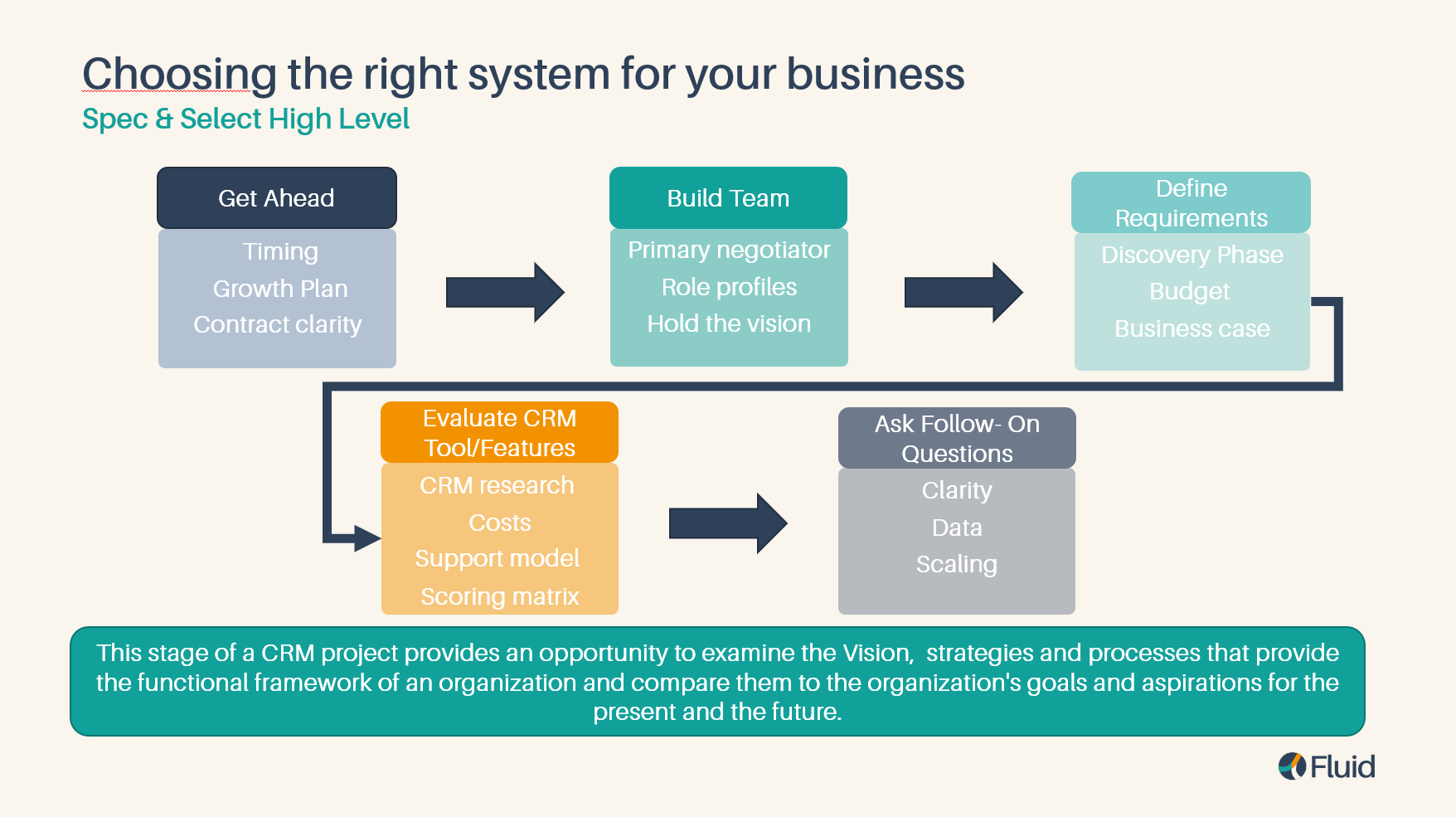
We heard in a previous blog about what to expect from a modern CRM, and the benefits they can bring to your business, as well as the challenges of choosing the right one.
These challenges included:
- A bewildering array of choice
- There is often a trade off between usability and functionality
- Different systems are aimed at different sizes of organisation - many may offer too much functionality for smaller SMEs
- Opaque pricing structures make it difficult to write a business case or calculate total cost of ownership
- The CRM will likely need to be able to integrate tightly into your existing architecture to ensure a single customer view of data
- Its not just about choosing the system, but choosing a great partner too
One of our project managers Andy McGuinness has helped a number of Fluid clients to choose a CRM and to then implement them effectively. He has built a wealth of experience up along the way.
Andy outlined 5 steps that customers should go through for choosing the right system:

- Get Ahead – Timing and planning ahead is crucial. It's never too early to start researching CRM's and building a knowledge base. Use this time to make sure your CRM project is aligned with a solid growth plan (whether the focus is to increase customer retention or build a new customer base) and ensure you develop a solid vision for your sales and customer experience at this stage.
Also, if you already have a CRM or some systems that you hope to replace with your CRM, contractual clarity is always a big advantage. When do the contracts for your current systems expire, are there break clauses, what are you currently spending on them and where are the gaps in functionality that are holding you back?
Summary of this stage – you get to understand your own needs.
- Building a Team – At this early stage its vital to establish who will be involved. A solid team should include a breadth of business and IT stakeholders.
So not only should your CIO and IT leads be involved but it is of paramount importance to engage the heads of business areas affected. For example Sales/Marketing/Customer engagement, and also Subject Matter Experts (SME's) from within their teams who understand detailed processes and can help with requirements.
Remember, for any new system selection and implementation to succeed, its important that its seen as a business project, not an IT project. The business needs to lead and to put their very best people on the project, not those they can afford to lose. After all, you want your best people to be the ones establishing your vision for how your system and process should work in future, not your least capable.
Summary of this stage – maximise business engagement and buy-in by forming a representative team
- Requirements – Its vital to have a good understanding of the key "must have" uses cases. This initial discovery phase can drive this out.
If you are looking for your CRM to really help drive a step change in business outcomes - which you should be - then this is where the need for a well thought out vision for the future comes in. Otherwise you are at risk of simply recreating how you do things currently on a new and potentially more expensive system.
Your clear vision needs to spell out how you want marketing, sales, service to hang together and operate, to really drive out value against the business case.
Requirements should not only include 'functional requirements' (i.e. things you want your CRM to be able to do) but also 'non-functional' requirements, for example you want it to be cloud based, or have a mobile app that's accessible for your sales team out on the road.
Summary of this stage – be crystal clear about what is most important for your business
- CRM Evaluation - Once high level use cases are understood then we begin the assessment of CRMs shortlisted in step 1, to see how well they meet them. This is where you can look at the exciting things like features, look and feel, and evaluate how the overall packages align with your vision and strategy and meet your requirements.
Its important at this point to make a structured, objective evaluation using tools like a scoring matrix, and take great care to involve those users and departments who will be most impacted in the actual evaluation.
The purpose of this is to take the emotion out of the decision, but also to make sure that all of your businesses requirements are considered, and that those requirements are weighted and prioritised according to which are most important to you.
But this step is also about building buy in from your team. By involving them in the journey right from the outset and in the decision, you're building their good will and making them more accountable for the resulting choice. So you need to make sure that your team get the opportunity to actually have a considered play around with the systems being evaluated, and not just allow generic demonstration led by the CRM sales professionals.
To aid this it can be helpful to establish some real life scenarios for things you want to try out in the CRM, and have the partner set up some dummy data for your team to evaluate how the key use cases look and feel in a way where it feels 'real' to them and your business.
You also need to evaluate the partner match and support model at this stage to a make sure there is a good cultural fit, and the support model meets your businesses needs.
Its easy at this point to be led by the vendor, but we believe its very important not to go down a vendor-led route. Vendors can easily distract with "shiny, shiny" - exciting functionality like AI-enabled workflows or natural language processing, which can distract from your blueprint vision and increase costs with unnecessary features, "bells and whistles".
Finally we’d also usually advocate speaking to other business users of each system and vendor to get real life impressions to evaluate their more outspoken claims.
Summary of this stage – take the emotion out of the decision, get buy in from the team, and make an objective and structured choice
- Ask follow-on questions - Lastly having sat through solution demo's and scoring workshops from multiple vendors, there will be a whole host of follow up questions you'll need to ask.
One of the key things to watch out for is understanding the implementation approach, and possible hidden effort in getting the system up and running.
Clarity of questions on licenses such as when do you have to buy them (for some vendors it might be up front). But also understanding master data sets that you may need to define, and data migration approaches are a must.
Data migration and data cleanse is notorious for requiring more effort than you might anticipate, and needs substantial input from the business as only they know whether business data is correct and complete or not.
Many CRM systems and vendors will state that their system can meet certain if not most functional requirements, but the thing to watch out for is how long it will take you to set up and configure the CRM for that functionality to work.
Its all very well getting excited about automated workflows, but somebody needs to set them up and the time investment can be substantial. Total clarity should be established with the vendor to understand how far they are going to take you in their implementation proposal, and where you need to pick up the baton. Otherwise you and your users can be left disappointed, and with lots of work to do after the vendor has handed over to you.

In fact, getting the CRM live will only be the first part of the journey. You'll then be spending probably the best part of the first year getting it configured exactly how you need it, training your users and ensuring it gets embedded in your business before you start seeing an ROI.
You need to be clear about this at the outset with your team, and ensure you plan to make it happen.
Summary of this stage – Clarify the high level scope and critical path for implementation.
Our next blog deals with effective implementation of a CRM solution and how to manage the solution partner to ensure success.